Abstract
In response to dramatic changes in the environment, and supported by advances in wireless networking, pervasive sensor networks have become a common tool for environmental monitoring. However, tools for on-site visualization and interactive exploration of environmental data are still inadequate for domain experts. Current solutions are generally limited to tabular data, basic 2D plots, or standard 2D GIS tools designed for the desktop and not adapted to mobile use. In this paper, we introduce a novel augmented reality platform for 3D mobile visualization of environmental data. Following a user-centered design approach, we analyze processes, tasks, and requirements of on-site visualization tools for environmental experts. We present our multilayer infrastructure and the mobile augmented reality platform that leverages visualization of georeferenced sensor measurement and simulation data in a seamless integrated view of the environment.








Similar content being viewed by others
Notes
École Polytechnique Fédérale de Lausanne.
References
Aberer K, Alonso G, Barrenetxea G, Beutel J, Bovay J, Dubois-Ferrière H, Kossmann D, Parlange M, Thiele L, Vetterli M (2007) Infrastructures for a Smart Earth—the Swiss NCCR-MICS initiative. Prax der Informationsverarbeitung und Kommun 30(1):20–25
Baggi S, Schweizer J (2009) First results on characteristics of wet snow avalanche activity in a high alpine valley. Nat Hazards 50(1):97–108
Beyer H, Holtzblatt K (1998) Contextual design: defining customer-centered systems. Morgan Kaufmann, Burlington
Bogue R (2008) Environmental sensing: strategies, technologies and applications. Sens Rev 28(4):275–282
Burns M, Klawe J, Rusinkiewicz S, Finkelstein A, DeCarlo D (2005) Line drawings from volume data. ACM Trans Graph TOG 24(3):512
ESRI (2004) ArcPad®: Mobile GIS. Technical report, ESRI
Falk MG, Denham RJ, Mengersen KL (2009) Spatially stratified sampling using auxiliary information for geostatistical mapping. Environ Ecol Stat 18(1):93–108
Hart JK, Martinez K (2006) Environmental sensor networks: a revolution in the earth system science? Earth Sci Rev 78(3–4):177–191
Hengl T (2006) Finding the right pixel size. Comput Geosci 32(9):1283–1298
Hilbich C, Hauck C, Hoelzle M, Scherler M, Schudel L, Völksch I, Mühll DV, Mäusbacher R (2008) Monitoring mountain permafrost evolution using electrical resistivity tomography: a 7-year study of seasonal, annual, and long-term variations at Schilthorn, Swiss Alps. J Geophys Res 113(F1):1–12
Höllerer T, Feiner SK (2004) Mobile augmented reality. Telegeoinformatics LocationBased Computing and Services, pp 1–39
Jeung H, Sarni S, Paparrizos I, Sathe S, Aberer K, Dawes N, Papaioannou TG, Lehning M (2010) Effective metadata management in federated sensor networks. 2010 IEEE international conference on sensor networks ubiquitous and trustworthy computing, pp 107–114
Kim S, Paulos E (2009) inAir: measuring and visualizing indoor air quality. In: Proceedings of the 28th international conference on human factors in computing systems CHI 10. ACM Press, pp 1861–1870
King GR, Piekarski W, Thomas BH (2005) ARVino—outdoor augmented reality visualisation of viticulture GIS data. In: Werner B (ed), Proceedings of the 4th IEEE/ACM international symposium on mixed and augmented reality. IEEE Computer Society, pp 52–55
Kruijff E, Mendez E, Veas E, Gruenewald T (2010) On-site monitoring of environmental processes using mobile augmented reality (HYDROSYS). In envip 2010
Lehning M, Völksch I, Gustafsson D, Nguyen TA, Stähli M, Zappa M (2006) ALPINE3D: a detailed model of mountain surface processes and its application to snow hydrology. Hydrol Process 2128(May 2005):2111–2128
Lin C-R, Loftin RB (1998) Application of virtual reality in the interpretation of geoscience data. In: Proceedings of the ACM symposium on virtual reality software and technology 1998 VRST 98. ACM Press, pp 187–194
Liston GE, Sturm M (1998) A snow-transport model for complex terrain. J Glaciol 44(148):498–516
Mitas L, Mitasova H (1998) Distributed soil erosion simulation for effective erosion prevention. Water Resour Res 34(3):505–516
Mitterer C, Hirashima H, Schweizer J (2011) Wet-snow instabilities: comparison of measured and modelled liquid water content and snow stratigraphy. Ann Glaciol 52(58):201–208
Mitterer C, Mott R, Schweizer J (2009) Observations and analysis of two wet-snow avalanche cycles. In: International snow science workshop ISSW, number April 2008. Swiss Federal Institute for Forest, Snow and Landscape Research WSL, pp 262–266
Nocke T, Sterzel T, Böttinger M, Wrobel M (2008) Visualization of climate and climate change data: an overview. In: Ehlers EEA et al. (eds) Digital earth summit on geoinformatics 2008 tools for global change research ISDE08, Wichmann, Heidelberg, pp 226–232
Paxton M, Benford S (2009) Experiences of participatory sensing in the wild. In: Proceedings of the 11th international conference on ubiquitous computing ubicomp 09, p 265
Schuler D, Namioka A (1993) Participatory design: principles and practices. Routledge, London
Schweizer J, Jamieson JB, Schneebeli M (2003) Snow avalanche formation. Rev Geophys 41(4):1016
Shneiderman B (1996) The eyes have it: a task by data type taxonomy for information visualizations. In: Proceedings 1996 IEEE symposium on visual languages, pp 336–343
Simoni S, Zanotti F, Bertoldi G, Rigon R (2008) Modelling the probability of occurrence of shallow landslides and channelized debris flows using geotop-fs. Hydrol Process 22(4):532–545
Techel F, Pielmeier C, Schneebeli M (2011) Microstructural resistance of snow following first wetting. Cold Reg Sci Technol 65(3):382–391
Thomas JJ, Cook KA (2005) Illuminating the path: the research and development agenda for visual analytics, vol 54. IEEE
Veas E, Grasset R, Kruijff E, Schmalstieg D (2012) Extended overview techniques for outdoor augmented reality. IEEE Trans Vis Comput Graph 18:565–572
Veas EE, Mulloni A, Kruijff E, Regenbrecht H, Schmalstieg D (2010) Techniques for view transition in multi-camera outdoor environments. In: Graphics interface 2010 (GI’10), Toronto, Ont., 2010. Canadian Information Processing Society, pp 193–200
White S (2009) SiteLens: situated visualization techniques for urban site visits. Evaluation, pp 1117–1120
Yang J, Zhang C, Li X, Huang Y, Fu S, Acevedo MF (2009) Integration of wireless sensor networks in environmental monitoring cyber infrastructure. Wirel Netw 16(4):1091–1108
Acknowledgments
This work is partially funded by the EC 7th Framework project HYDROSYS (224416, DG-INFSO).
Author information
Authors and Affiliations
Corresponding author
Electronic supplementary material
Below is the link to the electronic supplementary material.
MPG (31440 KB)
Rights and permissions
About this article
Cite this article
Veas, E., Grasset, R., Ferencik, I. et al. Mobile augmented reality for environmental monitoring. Pers Ubiquit Comput 17, 1515–1531 (2013). https://doi.org/10.1007/s00779-012-0597-z
Received:
Accepted:
Published:
Issue Date:
DOI: https://doi.org/10.1007/s00779-012-0597-z




